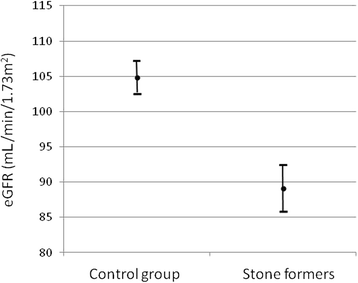Impact of nephrolithiasis on kidney function
- PMID: 26316205
- PMCID: PMC4551564
- DOI: 10.1186/s12882-015-0126-1
Impact of nephrolithiasis on kidney function
Abstract
Background: Kidney stone disease has been associated with reduced kidney function and chronic kidney disease (CKD). The objective of the study was to examine kidney function, body mass index (BMI) and the prevalence of cardiovascular disease, hypertension and diabetes in recurrent kidney stone formers.
Methods: A cross-sectional, case-control study comparing measures of kidney function, BMI and comorbid conditions was conducted in 195 kidney stone patients aged 18 to 70 years with recurrent clinical stone events and 390 age- and gender-matched controls. Wilcoxon-Mann-Whitney, chi-square tests and analysis of covariance were used to compare serum creatinine (SCr) and estimated glomerular filtration rate (eGFR) between the groups.
Results: The median age of stone formers was 51 (range, 19-70) years and 108 (55 %) were males. Seventy patients (36 %) had experienced 2-4 clinical stone events, 41 (21 %) 5-10 episodes and 84 (43 %) more than 10. The median SCr was 75 (41-140) μmol/L in the stone formers and 64 (34-168) μmol/L in the control group (p < 0.001). The mean eGFR was 87 ± 20 and 104 ± 22 mL/min/1.73 m(2) in the stone formers and controls, respectively (p < 0.001). After adjustment for body size and comorbid conditions, the difference in SCr and eGFR between cases and controls remained highly significant (p < 0.001). The prevalence of CKD was 9.3 % among stone formers compared with 1.3 % in the control group (P < 0.001). Hypertension and diabetes were significantly more prevalent among the cases that also had higher BMI than controls.
Conclusions: Recurrent kidney stone formers have a significantly lower level of kidney function and a markedly higher prevalence of CKD than age- and gender-matched control subjects. The observed deleterious effect of kidney stones on kidney function appears to be independent of comorbid conditions.
Figures
References
Publication types
MeSH terms
Grants and funding
LinkOut - more resources
Full Text Sources
Other Literature Sources
Medical
Research Materials
Miscellaneous


